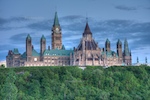
I’ve created my first high dynamic range (HDR) photos. I went on a photowalk last Friday with Mike and Haitham from the Nortel Photography Club. We started at the North end of Lower Town and moved across the Alexandra bridge to the Canadian Museum of Civilization.

My Canon 40D supports exposure bracketing, which is perfect for taking HDR photos. I set it to automatically take a metered exposure, then take one shot that is underexposed by 2 stops and one that is overexposed by 2 stops. The amount of over and underexposure can be configured in 1/3 or 1/2 stop increments. I also used the LiveView feature to take the photos, so that the mirror would not bounce, which would cause vibration and blurring. Even though I was using a tripod, I tried my EF-S 17-55mm f/2.8 lens with image stabilization on and off to see if it made a difference – it did not.
I downloaded a trial version of the Aperture Photomatix plugin by HDRSoft. I kept all of the settings on the defaults to create the HDR photos. It worked great. The price is high ($79.95 USD), which is why I have not bought it yet. Perhaps later this year if I feel a strong urge to create lots of HDR photos.
